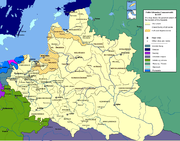
Treaty of Polanów
Encyclopedia

Peace treaty
A peace treaty is an agreement between two or more hostile parties, usually countries or governments, that formally ends a state of war between the parties...
signed on 14 June 1634 between the Polish-Lithuanian Commonwealth
Polish-Lithuanian Commonwealth
The Polish–Lithuanian Commonwealth was a dualistic state of Poland and Lithuania ruled by a common monarch. It was the largest and one of the most populous countries of 16th- and 17th‑century Europe with some and a multi-ethnic population of 11 million at its peak in the early 17th century...
and Tsardom of Russia
Tsardom of Russia
The Tsardom of Russia was the name of the centralized Russian state from Ivan IV's assumption of the title of Tsar in 1547 till Peter the Great's foundation of the Russian Empire in 1721.From 1550 to 1700, Russia grew 35,000 km2 a year...
in the village of Semlevo located near the Polyanovka river between Vyazma
Vyazma
Vyazma is a town and the administrative center of Vyazemsky District of Smolensk Oblast, Russia, located on the Vyazma River, about halfway between Smolensk and Mozhaysk. Throughout its turbulent history, the city defended western approaches to the city of Moscow...
and Dorogobuzh
Dorogobuzh
Dorogobuzh is a historic town and the administrative center of Dorogobuzhsky District of Smolensk Oblast, Russia, straddling the Dnieper River to the east of Smolensk and west of Vyazma. Population:...
.
The accord was signed in the aftermath of the Smolensk War
Smolensk War
The Smolensk War was a conflict fought between the Polish-Lithuanian Commonwealth and Russia.Hostilities began in October 1632 when Tsar forces tried to recapture the city of Smolensk, a former Russian possession. Small military engagements produced mixed results for both sides, but the surrender...
. The negotiations begun on 30 April. Overall, the agreement confirmed the pre-war status quo
Status quo ante bellum
The term status quo ante bellum is Latin, meaning literally "the state in which things were before the war".The term was originally used in treaties to refer to the withdrawal of enemy troops and the restoration of prewar leadership. When used as such, it means that no side gains or loses...
, with Russia paying a large war indemnity (20,000 rubles
Russian ruble
The ruble or rouble is the currency of the Russian Federation and the two partially recognized republics of Abkhazia and South Ossetia. Formerly, the ruble was also the currency of the Russian Empire and the Soviet Union prior to their breakups. Belarus and Transnistria also use currencies with...
in gold
Gold
Gold is a chemical element with the symbol Au and an atomic number of 79. Gold is a dense, soft, shiny, malleable and ductile metal. Pure gold has a bright yellow color and luster traditionally considered attractive, which it maintains without oxidizing in air or water. Chemically, gold is a...
) for Wladislaus IV agreeing to surrender his claim to the Russian throne and return the royal insignia to Russia. Władysław, despite holding an upper hand, was trying to bring the Russia into an anti-Sweden alliance; hence in a gesture of goodwill he agreed to give the Russians the border town of Serpeysk
Serpeysk
Serpeysk is a village in Meshchovsky District of Kaluga Oblast, Russia, located on the Serpeyka River. It was first noted in 1406 as a military fort on the boundary between Muscovy and the Grand Duchy of Lithuania. During the 16th and 17th centuries, the town changed hands several times. It was...
and nearby territories. However, the alliance never came through, as the Polish Sejm
Sejm
The Sejm is the lower house of the Polish parliament. The Sejm is made up of 460 deputies, or Poseł in Polish . It is elected by universal ballot and is presided over by a speaker called the Marshal of the Sejm ....
, unwilling to fight Sweden after the Treaty of Sztumska Wieś
Treaty of Sztumska Wies
The Treaty of Stuhmsdorf or Sztumska Wieś was a treaty signed on 12 September 1635 between the Polish–Lithuanian Commonwealth and Sweden in the village of Stuhmsdorf , Royal Prussia, just south of Stuhm ....
, subsequently objected, and Russians saw no benefit in such an alliance. The sides also reached an agreement on prisoner exchange and a trade treaty.
The treaty ended the almost unbroken series of wars between the Commonwealth and its neighbours that had been waged since the beginning of the 17th century. The fourteen years of peace that followed were arguably the most prosperous in Commonwealth's history.

